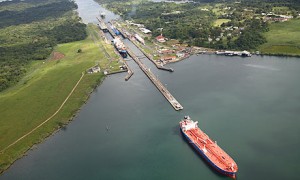Background:
The Panama Canal was built and developed in 1914 linking the Pacific and Atlantic Oceans making international trade much faster and cheaper than ever. But in Feb 2011 Colombia announced that with the help of China, they were building an alternative rail-based overland route to compete with the Panama Canal. But with the effectiveness of the Panama Canal, why would China want to develop an alternative?
Many nations throughout history have tried to create/find/develop overland canals, with very few success stories. It took the United States 10 years to create the Panama Canal, with great financial, environmental, and human cost. Approximately 22,000 workers died during the canal development but the global impact on world trade has been tremendous.
The US controlled the Panama Canal until 1977, and jointly-controlled it with the Panamanian government until 2000.
There have been several alternative Pacific-Atlantic passages attempted, but to date the Panama Canal is the only completed canal.
The major problem with the Panama Canal is that it has a maximum ship size of 65,000 tons. Modern ships far exceed this size, for example the Suez Canal in Egypt has a maximum of 240,000 tons. So the Panama Canal needs to greatly expand its capacity, or else nations will develop an alternative. They are currently working on a $5 billion project to double capacity, however they are facing competition from cheaper alternatives.
The current alternatives are the Northwest Passage – the route through northern Canada that used to be totally frozen. However with the onset of global warming, the ice shelf is melting allowing greater access to ships.
Another option is the Ecocanal Project in Nicaragua, being developed by the 2 South Korean companies. Dongmyeong Engineering & Architecture Consultants (DMEC) and Ox Investments will invest $500 million on the project, which will include a large seaport at Monkey Point and Pacific-Atlantic canal.
However the China have announced that they are building a seaport in Cartagena on Colombia’s Caribbean shore with a massive rail terminal connected. There will also be a rail link to another port on the Pacific. They will use this overland rail link to ferry goods across South America to awaiting ships.
But there is a larger purpose to this development. South America is a very advancing economy and has immense national resources. China will need easy access over the coming decades to South America, and especially to Brazil, to meet the needs of their rapid growth. They believe that this will be the best way to do this via their extensive rail network and Colombian seaport, as well as from the almost-completed the Açu superport, which is designed to handle 400,000 ton Chinese tankers.
Analysis:
China is growing at an alarming rate, and has recently surpassed Japan as the second largest economy in the world. It is estimated that they will surpass the United States in15-20 years. But to sustain this, they will need access to many goods and natural resources. That is why they are investing heavily in South America’s transportation industry. They are also deeply entrenched in the development of similar projects in Africa.


No comments:
Post a Comment